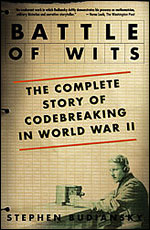Doolittle’s Raid
Converted for the Web from “Battle Of Wits: The Complete Story Of Codebreaking In World War II” by Stephen Budiansky
Joseph J. Rochefort | Stealing the Japanese Code | War Against Japan
After Pearl Harbor | A Man with a Mission | War Against Bureaucracy
Ambush the Ambushers | The Battle of Midway
Denouement: Intelligence Vindicated
 Green water breaking across her flat topside, the U.S. carrier Hornet plunged through a heavy sea and strong wind. A few hours earlier, as dawn broke on April 18, 1942, lookouts aboard the American ship had spotted a Japanese patrol boat. The Hornet’s planes were intending to carry out their raid under cover of darkness, but Admiral William Halsey, whose nickname “Bull” had not been bestowed lightly, gave the order to launch at once — wind, wave, and daylight be damned. The ship swung into the wind, and at 7:25 A.M. the first of the twin-engine bombers groaned off the flight deck.
Green water breaking across her flat topside, the U.S. carrier Hornet plunged through a heavy sea and strong wind. A few hours earlier, as dawn broke on April 18, 1942, lookouts aboard the American ship had spotted a Japanese patrol boat. The Hornet’s planes were intending to carry out their raid under cover of darkness, but Admiral William Halsey, whose nickname “Bull” had not been bestowed lightly, gave the order to launch at once — wind, wave, and daylight be damned. The ship swung into the wind, and at 7:25 A.M. the first of the twin-engine bombers groaned off the flight deck.
The Army pilots at the controls of the B-25s had practiced short takeoffs from the comfortably dry land of a Florida airstrip but had never once tried it at sea. No one else ever had, either. Landing a B-25 on a carrier was impossible. Flying a B-25 off a carrier was, by comparison, merely insane. But the medium-weight bombers were the only aircraft in the American arsenal with a prayer of completing the daredevil mission. If all went according to plan, they would fly five hundred miles to Japan, drop their load, then continue another eleven hundred miles to a safe landing in unoccupied China.
Leading the attack was an unflappable test pilot, Lieutenant Colonel James H. Doolittle; his was the first of the lumbering bombers to catapult down the heaving deck. Over the next hour fifteen others followed. One pilot hung on the verge of a stall for so long as he struggled to get airborne that, Halsey later recalled, “we nearly catalogued his effects.” Thirteen of the planes headed for Tokyo, roared in over the rooftops from different directions, and dropped their four bombs apiece. The three others hit Nagoya and Osaka. Ever since the attack on Pearl Harbor four months earlier, President Franklin D. Roosevelt had been pressing for just such a morale-boosting coup to bolster some of America’s wounded pride. The Doolittle raid had been his pet project, and he was exultant with the news. Asked by reporters where the planes had come from, FDR grinned and said, “Shangri-La.”
Doolittle’s Raiders did essentially no damage — except to the Japanese psyche. On that they scored a direct hit. The Japanese Army claimed it shot down nine of the marauders; the true figure was zero. But the premature launch of the planes had added almost two hundred miles to their planned mission, strong head winds burned up still more fuel as they made their way toward China, and most of the crews ditched or bailed out. Eight who landed in Japanese-occupied territory were taken prisoner and three of them were executed, ostensibly for the crime of bombing civilian targets but in reality in an excess of Japanese fury and mortification.
Jump to: Doolittle’s Raid | Admiral Isoroku Yamamoto
Joseph J. Rochefort | Stealing the Japanese Code | War Against Japan
After Pearl Harbor | A Man with a Mission | War Against Bureaucracy
Ambush the Ambushers | The Battle of Midway
Denouement: Intelligence Vindicated
Copyright © 2000 by Stephen Budiansky. All rights reserved. Converted for the Web with the permission of Simon & Schuster.
Click to Amazon to buy “Battle Of Wits: The Complete Story Of Codebreaking In World War II.”
